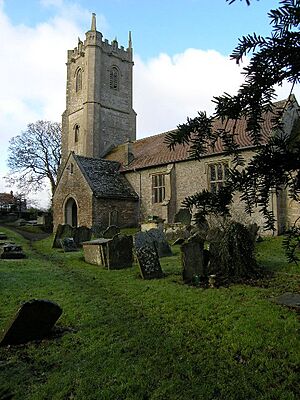Abson facts for kids
Quick facts for kids Abson |
|
|---|---|
 St James the Great Church, Abson |
|
| Population | 1,930 (Wick and Abson) (2021) |
| • London | 113 mi (182 km) E |
| District | |
| Shire county | |
| Region | |
| Country | England |
| Sovereign state | United Kingdom |
| Post town | BRISTOL |
| Postcode district | BS30 |
| Dialling code | 0117 |
| Police | Avon and Somerset |
| Fire | Avon |
| Ambulance | Great Western |
| EU Parliament | South West England |
| UK Parliament |
|
Abson is a small village in South Gloucestershire, England. It is part of the larger area called Wick and Abson.
Where is Abson?
Abson is located on a small road. This road connects the villages of Wick and Pucklechurch. Most of Abson's homes are grouped together. This is called a nucleated village pattern. Some farms and houses are also found outside the main village area. The center of Abson has a small village green and a church.
Abson is part of the Church of England parish of Wick and Abson. It also belongs to the Thornbury and Yate area for Parliament.
Abson's History
The name Abson comes from an older name, Abbotston. This means "the place belonging to the Abbot." The Abbot was from Glastonbury. The land around Pucklechurch, including Abson, was given to the Abbot. This happened after King Edmund was murdered nearby in Pucklechurch. In the 1500s, the village was known as Abston. Later, its name became shorter, changing to Abson.
One of the houses in Abson is called Blue Lodge. This house was once home to Anna Sewell. She was the famous author of the book Black Beauty. While living there, she saw a man get hurt by a cart. This event inspired a scene in her well-known novel.
The Village Church
The village of Abson is built around its church. This church is named after St James the Great. It is a very important building, listed as a Grade I listed building. This means it has special historical or architectural value. The churchyard walls are also listed. They have unique black stone tops from Bristol. Many graves in the churchyard are also listed. The nearby farmhouse, stables, and barn are also listed. They are Grade II listed and have been turned into homes.
Inside the church, you can see two pieces of carved stone. They have a special knotwork design. High up on the East wall is a carving of a male figure. Experts believe this carving is very old. It might be from Saxon or early Norman times.
The church also has a pulpit from the early 1600s. A pulpit is a raised stand where a preacher gives a sermon. It has a special sounding board above it. There is also wooden artwork from the 1700s.
The church's belltower holds six bells. These bells are still rung by hand today.
Nearby Places
 |
Mangotsfield | Pucklechurch | Hinton |  |
| Siston | Dyrham | |||
| Bridgeyate | Wick | Doynton |


